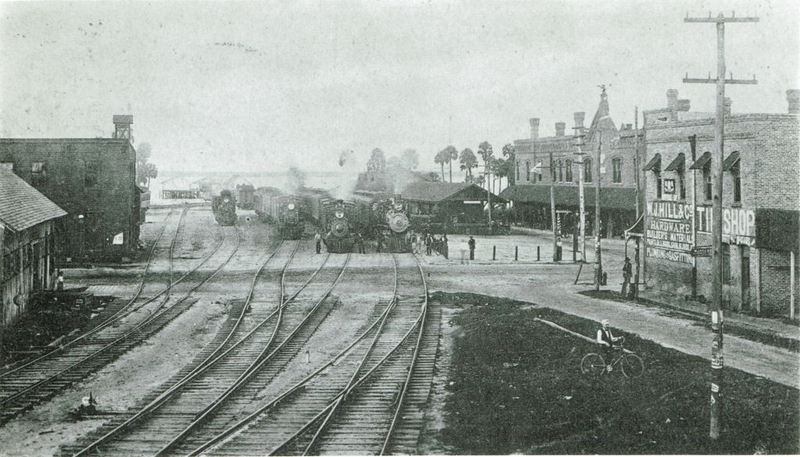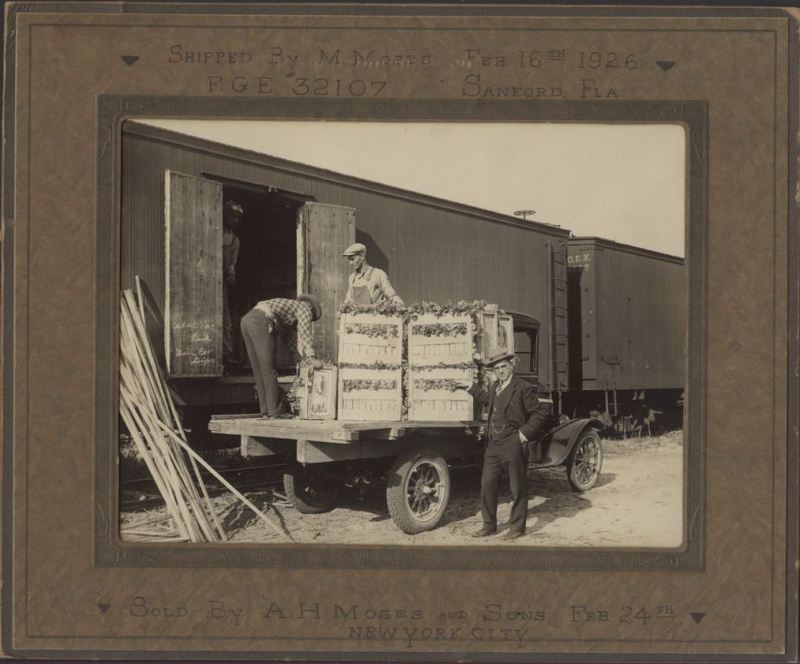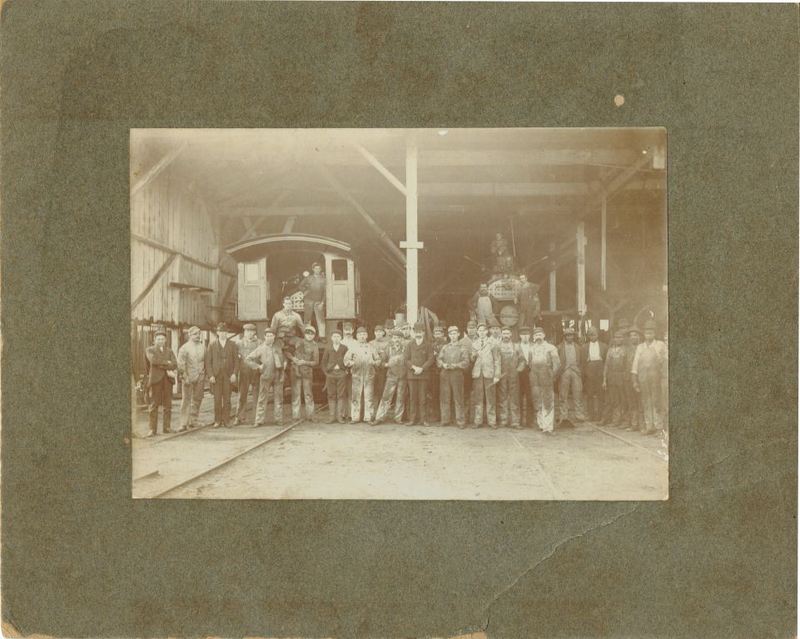Sanford Railroad Depots
Sanford’s railroad industry has evolved over time to serve the needs of the growing city. The city was incorporated on September 29, 1877, and less than three years later, on January 10, 1880, groundbreaking ceremonies for the South Florida Railroad station on Oak Avenue were staged by Henry Shelton Sanford (1832-1891), a former U.S. Minister to Belgium and senior officer of Adams Express Company. Former president Ulysses S. Grant (1822-1885), a friend of Sanford, was visiting Florida at the time and threw out the first ceremonial spadeful of dirt.[1]
The eastern terminus for the railroad, Sanford sits on the west bank of Lake Monroe, which served as the head of navigation on the St. John’s River. In 1870, Henry Sanford purchased 12,548 acres and created his planned city.[2] After forming a land company, recruiting English and Swedish settlers, and cultivating citrus groves, the city developed into a major railroad and steamboat junction. Eager to provide service to Florida’s east coast, one of the South Florida Railroad’s prime movers, Robert Pulsifer, had a new subsidiary charted called the Sanford & Indian River Railroad, which meant to connect Sanford with Titusville, the head of navigation on the Indian River. However, funding the Indian River Division conflicted with the desire to reach Kissimmee, and only a 6.5-mile segment was completed between Sanford and Lake Jessup in 1883.[3]
The Plant System was a system of railroads, steamships, and hotels that operated from 1860 to 1902 in South, Central, and Coastal Georgia with lines extending down into Port Tampa and Punta Gorda, Florida. The system was named after its owner and president, railroad developer Henry Bradley Plant (1819-1899). In 1883, the Plant System purchased 60 percent of the stock of the South Florida Railroad, which ran from Sanford to Tampa.[4] Connecting Sanford and Kissimmee, the South Florida Railroad was one of the most strategic purchases that Henry Plant made. In 1885, Plant upgraded Sanford’s railway facilities, adding a new passenger depot and freight house, as well as shops to repair company locomotives and cars.[5] Plant purchased the remainder of the railroad in 1893, incorporating it into his own system.
During the last two decades of the 19th century, Sanford gained numerous rail lines, adding a handful of depots and other railroad structures. In 1893, the Orange Belt Railway was sold and reorganized as the Sanford & St. Petersburg Railroad. After struggling for two more years, it was leased to the Plant Investment Company.[6] When the Jacksonville, Tampa & Key West Railway was completed in February 1886, connecting Jacksonville and Sanford, trains became the fastest conveyor of passengers and freight between those cities.[7]
In 1902, upon Henry Plant’s death, his widow, Margaret Josephine Loughman, sold the railroad system to the Atlantic Coast Line (ACL) Railroad Company. The arrival of the ACL transformed the region, bringing in new railroad workers and citrus and celery farmers.[8] Rand Yard, ACL’s freight yard, housed a car shop, an engine servicing facility, a small locomotive shop, and the state’s largest railroad ice plant.[9] Lake Jesup farmers began demanding that the ACL build a line to ship their produce into town. When the ACL refused, the region’s five most prominent growers chartered the Sanford and Everglades Railroad, with Sydney Octavius Chase as the president.[10] The new line was completed as a component of the ACL’s Lake Charm branch. The ACL was prompted to buy out the new line in 1913, when the Seaboard Air Line showed interest in purchasing it.[11] Nicknamed the Celery Branch Line, the branch became the most profitable in the ACL system.
In 1963, the ACL replaced the previous depot from 1913 with a new station on the main line to serve Sanford, allowing for more efficient operations.[12] In 1967, the ACL was acquired by the Seaboard Coast Line (SCL) Railroad. The station was used by Amtrak until August 2005, when they vacated due to rundown conditions. The property is currently owned by CSX Transportation, sitting derelict with an uncertain future.[13] In the 1970s, a new era in railroad history began for Sanford when the city became the southern terminus for Amtrak’s Auto Train, Amtrak’s only rail service to simultaneously transport passengers and their motor vehicles, including cars, SUVs, trucks, motorcycles, small boats, and water skis.[14] When fully assembled, Amtrak’s Auto Train is the longest regularly scheduled passenger train, growing up to 50 cars long. The city continues to play a significant role in Florida’s railroad history, becoming the eastern terminus for the SunRail in 2014. The station is located on the former site of the Rand Yard.
[1] Gregg M. Turner and Seth H. Bramson, The Plant System of Railroads, Steamships and Hotels (Laurys Station, PA: Garrigues House, Publishers), 43.
[2] Turner and Bramson, The Plant System of Railroads, Steamships and Hotels.; "Sanford – Auto Train, FL (SFA)," Amtrak Presents Great American Stations, accessed December 23, 2015, http://www.greatamericanstations.com/Stations/SFA.
[3] Turner and Bramson, The Plant System of Railroads, Steamships and Hotels.; "Sanford – Auto Train, FL (SFA)."
[4] Gregg M. Turner, A Journey into Florida Railroad History (Gainesville: University Press of Florida, 2008), 124-126.; Turner and Bramson, The Plant System of Railroads, Steamships and Hotels, 47.
[5] Turner and Bramson, The Plant System of Railroads, Steamships and Hotels, 58.
[6] Ibid. 76.
[7] Ibid. 91.
[9] Jim Robison, "Once a Major Railroad Hub, Sanford’s Rand Yard Could Thrive Again," The Orlando Sentinel, October 4, 1992, accessed December 23, 2015, http://articles.orlandosentinel.com/1992-10-04/news/9210020429_1_florida-railroad-rand-sanford.
[10] Jim Robison, "Railroad Won't Go to Celery, So Farmers Built a Railroad," The Orlando Sentinel, March 22, 1998., accessed December 23, 2015, http://articles.orlandosentinel.com/1998-03-22/news/9803201118_1_celery-florida-railroad-sanford.
[11] Ibid.
[12] Michael Mulligan, Railroad Depots of Central Florida (Charleston, SC: Arcadia Publishing, 2008), 49.
[13] Ibid.
[14] "Sanford – Auto Train, FL (SFA)."


